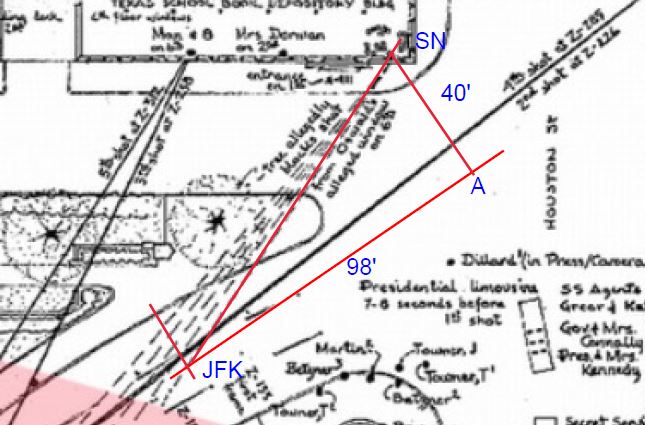[Edit: Joe, it's ok. I did the vertical angle at 3.5 degree change in 1 second which, with the 3.22 horizontal angle works out to 4.75 degrees per second total. close enough.]
I am not sure how you are doing your calculation of the angular speed at z153.
I started a thread on how to calculate angular velocity in 3-D space. It is at:
How to Calculate the Angular Velocities of a Target
https://www.jfkassassinationforum.com/index.php/topic,2640.msg93376.html#msg93376Given 3 angles, the distance and the speed of the target, one can plug in these values in a formula to calculate the angular velocity of the target in 3-D space.
And the thread I started on the 1908 Olympic Running Deer Competition is at:
Running Deer Shooting at the 1908 Olympics.
https://www.jfkassassinationforum.com/index.php/topic,3570.msg139366.html#google_vignetteA Wikipedia article on these competitions is at the following site. I use the 1908 Olympics because this article provided the most details on that competition.
https://en.wikipedia.org/wiki/100_meter_running_deerAt z 153 the rifle would be at a horizontal angle to the direction of the car of arctan(40/98)=22.2 degrees based on this diagram:

So if the car moves 18.3 feet in one second (1 foot per zframe or 12.5 mph) the 98 feet is now 116.3 feet so the angle is arctan(40/116.3)=18.98 degrees. That is a difference of 3.22 degrees in one second, horizontally. You would then have to work out the change in vertical angle as well which I haven't yet done and work out the total angle (one can't just add them together because they are at right angles). One has to take into account the 3 degree downward slope of Elm St. You might be right. But I would be interested to know how you get 4.8 degrees.
[/i]We don't know what targets Oswald shot at. I don't think we can say he had no experience in shooting at a moving target.
Re:Oswald half standing: Why would he assume such and uncomfortable position to fire at z160 when he knew he could comfortably kneel and take shots farther down Elm St. ?
I think Oswald made a mistake shooting at z153 which was such a difficult shot, because of the high angular velocity and awkward stance he would have to assume to fire at such a steep angle downward.
I would guess he did so because he may have feared that if he waited until after the target cleared the tree, the follow up limousine with the standing Secret Service Agents might block his line of sight. As it turned out, they didn't, but he would not have known that at z153. If this is not the reason then I have no idea why he attempted such a difficult shot where it appears he could not line up the iron sights with Kennedy.
Shooting at a target moving in a straight line at constant speed should not be difficult. If the shooter is tracking the target in the sights, the only question is how far it moves between the trigger being pulled and the bullet hitting the target.
But we know for a fact that this is difficult. In the 1908 Olympics the shooters each had ten attempts at a target moving at 3.2 degrees per second. With each attempt they would get just one shot. A minute or two later, the target would be moved back and they could make their next attempt until all ten shots were made.
It shooting at a stationary target, I would expect all shooters to score 40 points, to get each shot with a few inches of the center of the central bullseye.
The best of them scored 25 out of a possible 40 points on the moving target. So that indicates he was able to get most shots within a 6 inches (I guess) of the center of the target, assuming the "2", "3" and "4" concentric circles were 12 inches, 8 inches and 4 inches across (just my guess). So that he typically scored two or three points on most shots to get a score of 25.
The worst shooter scored 3 points, meaning he generally missed all the concentric circles and the deer outline. So he missed most shots by around two feet or more. Only on about three shots did he git a hit on the deer outline.
So clearly shooters, even good shooters, with prior practice (I assume) at a moving target, did have difficulty hitting a target moving at a pretty constant angular velocity of 3.2 degrees per second. I suspect the scores would have been a lot worst if the target was moving at 4.8 degrees per second. Perhaps the shooter who won the gold medal would have only gotten three points if it was moving that fast.
Experienced shooters do have problems consistently hitting a target moving at a pretty constant 3.2 degrees per second. That is shown in real world shooting competitions. There is no reason to think that Oswald would do as well as even the worst of the 1908 Olympic shooters. Hence the z153 shot missing the limousine does not seem to be wildly improbable.